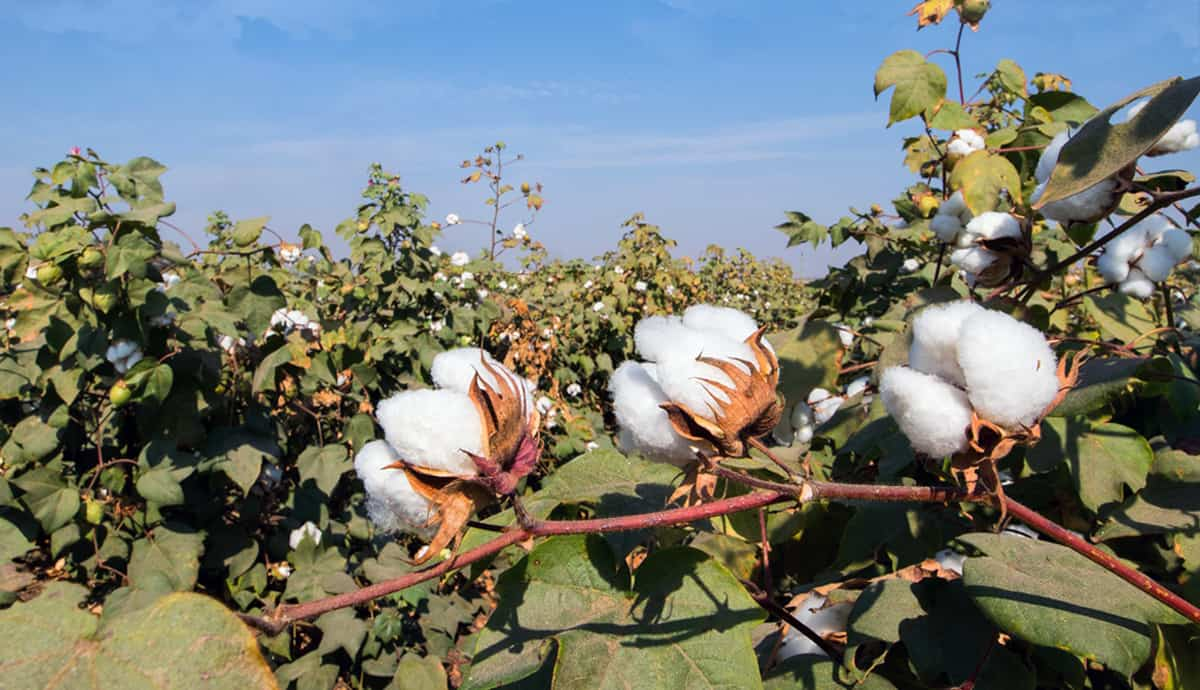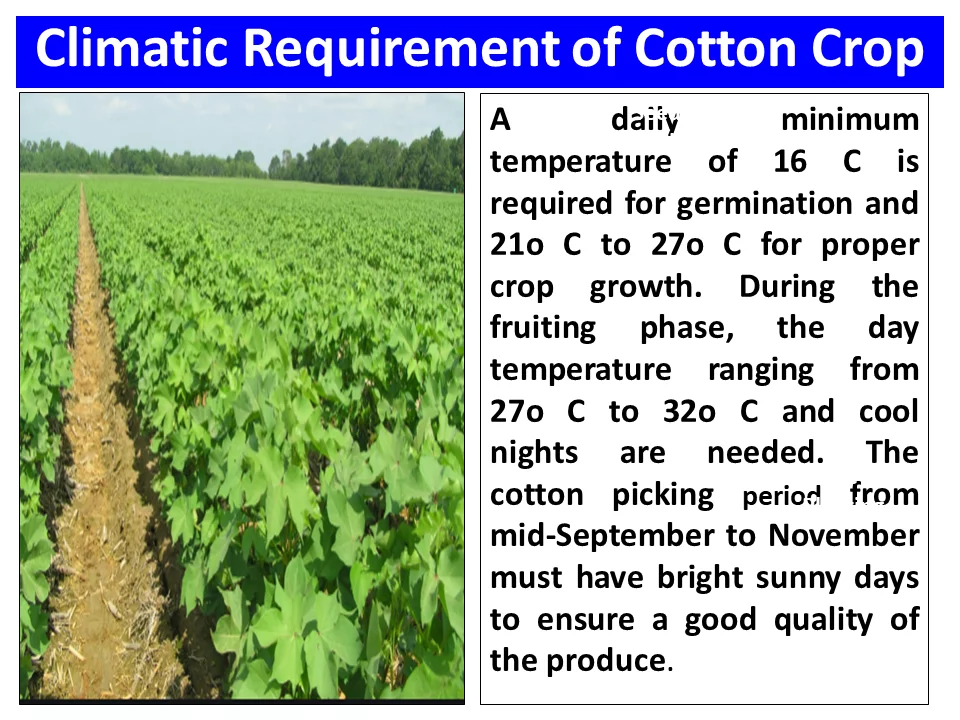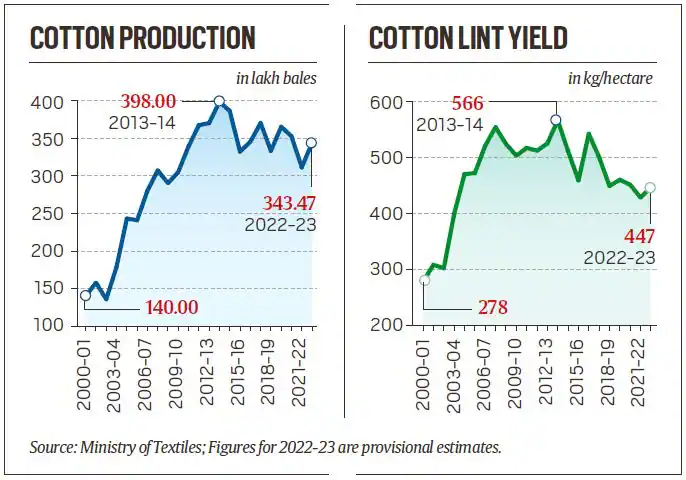
Copyright infringement not intended
Picture Courtesy: thenewsmill.com
Context: India's cotton production is facing a serious challenge from the pink bollworm, a pest that damages the crop and reduces the yield. The conventional methods of pest control, such as pesticides and genetically modified seeds, have not been very effective in containing the problem.
Details
- Cotton is an important crop in India that serves multiple purposes. It provides food in the form of cottonseed oil, feeds in the form of protein-rich cottonseed cake, and fibre used in the textile industry.
- The growth of cotton production in India from 2000-01 was significantly driven by the adoption of genetically modified (GM) cotton hybrids known as Bt cotton. These hybrids were engineered to resist the American bollworm insect pest, leading to increased yields.
- The success of Bt cotton was challenged by the emergence of the pink bollworm (PBW), which began infesting cotton crops in various states. Unlike the American bollworm, PBW is monophagous, primarily feeding on cotton, and it developed resistance to Bt proteins over time.
- Traditional insecticides had limited efficacy against PBW, so alternative approaches were explored. One such method is "mating disruption," which involves using artificial pheromones to prevent mating and egg-laying by PBW moths.
- Two products, PBKnot and SPLAT, were developed to implement mating disruption. PBKnot uses a dispenser with synthetic pheromone to attract male PBW moths, while SPLAT-PBW is an emulsion formulation delivering the pheromone. These products aim to reduce PBW populations and increase cotton yields.

Cotton production in India
About
- India has historically been the world's largest producer of cotton, accounting for approximately 25% of global cotton output.
- India is facing a significant decline in cotton exports during the current financial year. This decline is attributed to multiple factors, including a shift by farmers to more profitable crops like oilseeds and pulses, leading to a drop in cotton production.

Picture Courtesy: fertiliserindia.com
Factors that have contributed to the decline in cotton farming
Climate Change
- Climate change has had a significant impact on cotton farming in several ways.
- Erratic Rainfall Patterns: Changing climate patterns have led to unpredictable and irregular rainfall, which is detrimental to cotton crops. Cotton requires specific amounts of water at various growth stages, and irregular rainfall can lead to water stress, affecting the crop's yield and quality.
- Extreme Weather Events: Increasing frequency and intensity of extreme weather events such as droughts, floods, and hurricanes can devastate cotton fields. Floods can damage cotton plants, while droughts can lead to water scarcity and stunted growth.
- Temperature Extremes: Rising temperatures can also affect cotton crops by altering the flowering and fruiting patterns, making them less productive.
Pest and Diseases
- Cotton is vulnerable to a range of pests and diseases, and several factors have exacerbated this problem.
- Emergence of Resistant Strains: Over time, pests and diseases have evolved to become more resistant to conventional pesticides and control methods. This has made it increasingly challenging for cotton farmers to manage these threats effectively.
- Monoculture Farming: Continuous cotton cultivation in the same fields year after year can create favourable conditions for the buildup of pests and diseases. This practice, common in some regions, increases the risk of infestations.
High Input Costs
- The cost of agricultural inputs has risen steadily over the years, impacting the profitability of cotton farming.
- Seeds: High-quality cotton seeds are essential for a good yield. The cost of purchasing improved cotton varieties has increased, and genetically modified (GM) cotton seeds, which are resistant to certain pests, often come with licensing fees.
- Fertilizers and Pesticides: The cost of fertilizers and pesticides required to maintain cotton crops has also gone up. Farmers need to invest in these inputs to protect their crops and maintain yields.
- Labour and Machinery: Labor costs for planting, harvesting, and maintaining cotton crops, as well as machinery expenses, add to the overall input costs.
Competition from Other Crops
- Cotton faces competition for land and water resources from other more profitable or less risky crops like pulses and oilseeds.
- Profitability: Farmers may switch to crops like pulses or oilseeds because they offer higher market prices and returns compared to cotton. These crops are often less resource-intensive and have a shorter growth cycle, reducing the risks associated with cotton farming.
- Drought Resistance: Some alternative crops may be more resilient to changing climate conditions, making them a more attractive option for farmers in regions prone to water scarcity.
A combination of climate change-related challenges, increased pest and disease pressure, rising input costs, and competition from other crops has contributed to the decline in cotton farming.

Picture Courtesy: Indian Express
Decline in cotton production has far-reaching implications
Textile Industry
- The textile industry is a cornerstone of India's economy, employing millions of people and contributing significantly to the country's exports. A decline in domestic cotton production can have adverse effects on this industry.
- Higher Input Costs: Reduced domestic cotton availability may result in higher cotton prices in the domestic market. This can increase the cost of raw materials for textile manufacturers, potentially leading to reduced competitiveness in the global market.
- Job Losses: The textile sector is a major employer, especially in rural areas. A decline in cotton production can lead to reduced demand for labour in the cotton farming and ginning sectors, potentially causing job losses and affecting livelihoods in these regions.
- Impact on Exports: India is a significant exporter of textile and garment products. A drop in cotton production can affect the quantity and quality of cotton available for textile manufacturing, potentially impacting the export potential of the sector.
Dependency on Imports
- As domestic cotton production declines, India becomes more reliant on imported cotton to meet the demand of its textile industry. This dependence on imports can have several consequences.
- Vulnerability to Price Fluctuations: Global cotton prices can be volatile, influenced by factors such as weather events, international trade policies, and demand-supply dynamics. Relying on imported cotton makes India vulnerable to these price fluctuations, which can affect the cost structure of the textile industry.
- Supply Chain Disruptions: Imports introduce an element of uncertainty into the supply chain. Disruptions in the global cotton supply chain, such as shipping delays or trade disputes, can impact the timely availability of cotton for Indian textile manufacturers.
Economic Impact on Cotton Farmers
- The decline in cotton production directly affects cotton farmers, many of whom are smallholders. This has several economic and social consequences.
- Reduced Incomes: Lower cotton yields and profitability can lead to reduced incomes for cotton farmers. This can exacerbate their financial difficulties and lead to debt burdens.
- Rural Poverty: Cotton farming is a significant source of livelihood in rural areas. A decline in cotton production can contribute to rural poverty and increased vulnerability, as farming households may struggle to meet their basic needs.
- Migration: Economic hardships in rural areas can drive migration to urban centres in search of alternative employment opportunities, which can strain urban infrastructure and services.
Steps taken by the government
Financial Assistance
- Subsidies: The government provides subsidies to cotton farmers for essential inputs like seeds, fertilizers, and pesticides. These subsidies aim to reduce the financial burden on farmers and make cotton cultivation more economically viable.
- Minimum Support Price (MSP): The government sets a minimum support price for cotton, ensuring that farmers receive a fair price for their cotton produce. This price acts as a safety net, protecting farmers from price fluctuations in the market.
- Crop Insurance: The government offers crop insurance schemes that protect farmers against yield losses due to various factors, including adverse weather conditions, pests, and diseases. This helps farmers manage risks and recover losses in case of crop failure.
- Interest-Free Loans: In some cases, farmers are provided with interest-free or low-interest loans to finance their cotton farming activities, including purchasing seeds, fertilizers, and machinery.
Research and Development
- GM Cotton Varieties: India has invested in the development and promotion of genetically modified (GM) cotton varieties like Bt cotton, which are resistant to the bollworm pest. These varieties reduce the need for chemical pesticides, lowering production costs and minimizing environmental impacts.
- Climate-Resilient Varieties: Research efforts are focused on developing cotton varieties that are more resilient to the effects of climate change, such as drought-tolerant and heat-resistant strains. These varieties can thrive in adverse weather conditions and provide more stable yields.
- Pest and Disease Management: Government research institutions work on integrated pest management (IPM) strategies to control cotton pests and diseases sustainably. This includes the development of biological control methods and the promotion of natural predators.
Irrigation Improvements
- Drip and Sprinkler Irrigation: The government has promoted modern irrigation techniques such as drip and sprinkler irrigation, which are more water-efficient and help mitigate the impact of erratic rainfall. These methods ensure a consistent water supply to cotton crops.
- Canal Rehabilitation: Efforts are made to rehabilitate and modernize existing canal systems to ensure efficient water distribution to cotton-growing regions.
- Rainwater Harvesting: Encouragement and support are given to farmers for rainwater harvesting practices, which can supplement irrigation during dry spells.
Diversification Promotion
- Crop Rotation: Farmers are encouraged to practice crop rotation, which involves alternating cotton cultivation with other crops like pulses, oilseeds, or legumes. This reduces the risk of soil depletion and pest buildup, leading to more sustainable and productive farming.
- Awareness Campaigns: The government conducts awareness campaigns and provides training to farmers about the benefits of diversification. These campaigns aim to shift the mindset of farmers towards exploring alternative crops and improving overall agricultural resilience.
Challenges persist in the Indian cotton sector
Climate Change
- Erratic Weather Patterns: Climate change has led to unpredictable and erratic weather patterns, including irregular rainfall and more frequent extreme weather events like droughts and floods. These conditions pose a significant threat to cotton crops, affecting both yield and quality.
- Temperature Extremes: Rising temperatures can disrupt the flowering and fruiting stages of cotton plants. High temperatures during these critical phases can lead to poor fruit sets and reduced yields.
- Pest and Disease Outbreaks: Climate change can create favourable conditions for the proliferation of pests and diseases, making cotton crops more vulnerable. Warmer temperatures may allow pests to thrive year-round, increasing the need for pest management.
Fragmented Land Holdings
- Limited Adoption of Modern Farming Practices: Small and fragmented land holdings in India make it challenging for farmers to adopt modern and mechanized farming practices. Small plots of land may not justify the investment in expensive machinery, limiting productivity.
- Reduced Economies of Scale: Smaller land holdings often result in reduced economies of scale. Farmers may struggle to negotiate favourable prices for inputs, and their overall production costs may be higher compared to larger farms.
- Land Degradation: Intensive cultivation on small land parcels can lead to soil erosion and degradation, further reducing the long-term sustainability of cotton farming.
Lack of Awareness
- Limited Access to Information: Many cotton farmers, especially in remote or marginalized areas, have limited access to information about the latest agricultural technologies, best practices, and market trends. This lack of awareness can hinder their ability to make informed decisions.
- Traditional Farming Practices: Some farmers continue to rely on traditional farming practices, unaware of more sustainable and efficient methods that could enhance their crop yields and reduce costs.
Weak Infrastructure
- Inadequate Transportation: Poor rural infrastructure, including road networks, can hinder the timely transportation of cotton from farms to markets or processing units. This can lead to post-harvest losses and reduced profitability.
- Limited Access to Inputs: Weak infrastructure can impede farmers' access to agricultural inputs like seeds, fertilizers, and pesticides. Timely availability of these inputs is crucial for the success of cotton farming.
- Market Access: Farmers in remote areas may face challenges in accessing markets with fair prices for their cotton. Lack of proper marketing infrastructure and intermediaries in the supply chain can lead to lower returns for farmers.
Way Forward
Research and Development Investment
- Resilient Varieties: Increased investment in research and development is vital for developing cotton varieties that are not only resistant to pests and diseases but also resilient to the effects of climate change. This includes drought-tolerant and heat-resistant cotton strains.
- Organic and Sustainable Farming: R&D efforts should also focus on organic and sustainable farming practices that reduce the environmental impact of cotton cultivation, such as promoting natural pest control methods and improving soil health.
Irrigation Infrastructure
- Modernization: Investment in irrigation infrastructure, including the modernization of existing canal systems and the promotion of water-efficient technologies like drip and sprinkler irrigation, should be a priority. This will help farmers manage changing rainfall patterns and ensure consistent water availability.
- Rainwater Harvesting: Encourage the adoption of rainwater harvesting techniques at the farm level, allowing farmers to capture and store rainwater for irrigation during dry spells.
Diversification Promotion
- Crop Rotation: Promote crop rotation and intercropping to reduce dependence on cotton as the sole cash crop. Encourage the cultivation of complementary crops like pulses, oilseeds, or legumes, which can improve soil fertility and pest management.
- Market Linkages: Facilitate access to markets for alternative crops to ensure that farmers have profitable avenues for diversification.
Financial Assistance Continuation
- Subsidies and Support: Continue providing financial assistance to cotton farmers in the form of subsidies on essential inputs, minimum support prices, and crop insurance schemes. These measures help farmers cope with input costs and manage risks effectively.
- Credit Access: Ensure that farmers have access to affordable credit to finance their farming activities, including purchasing inputs, equipment, and adopting new technologies.
Infrastructure Improvement
- Transportation: Improve rural road networks and transportation infrastructure to facilitate the timely and cost-effective movement of cotton from farms to markets and processing units. This reduces post-harvest losses and ensures better returns for farmers.
- Access to Inputs: Strengthen the supply chain for agricultural inputs, making seeds, fertilizers, and pesticides readily available to farmers, especially in remote areas.
- Market Facilities: Develop market infrastructure in rural areas, including storage facilities and market yards, to create efficient and competitive markets for cotton and other agricultural products.
Education
- Extension Services: Expand agricultural extension services to reach more cotton farmers, providing them with knowledge about the latest farming technologies, best practices, and sustainable farming methods.
- Farmer Training: Conduct training programs and workshops to educate farmers on modern farming techniques, pest management, and water-saving practices.
- Digital Tools: Utilize digital platforms and mobile apps to disseminate information to farmers, including weather forecasts, market prices, and farming tips.

Conclusion
- The decline in cotton production in India presents a multifaceted challenge, encompassing economic, environmental, and agricultural dimensions. To overcome these challenges, India must prioritize research, technology adoption, irrigation infrastructure, diversification, financial support, infrastructure development, and farmer education. By embracing a comprehensive approach, India can revitalize its cotton sector, strengthen rural livelihoods, and ensure the resilience of this crucial crop in the face of evolving pressures and opportunities.
Must Read Articles:
COTTON SECTOR IN INDIA: https://www.iasgyan.in/daily-current-affairs/cotton-sector-in-india
COTTON INDUSTRY: https://www.iasgyan.in/blogs/cotton-industry-upsc
COTTON INDUSTRY: https://www.iasgyan.in/daily-current-affairs/cotton-industry
|
PRACTICE QUESTION
Q. What are the key challenges faced by cotton farming in India and how do these challenges affect the country's cotton industry? What strategies and approaches can be implemented to address these challenges and promote the long-term sustainable development of the cotton sector in India?
|
https://indianexpress.com/article/explained/explained-economics/why-indias-falling-cotton-production-is-a-worry-8933909/















